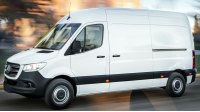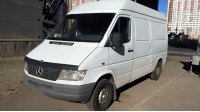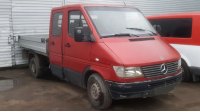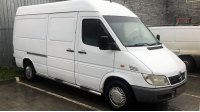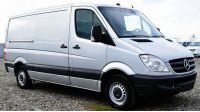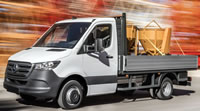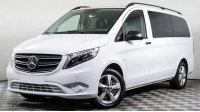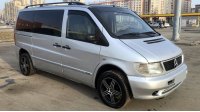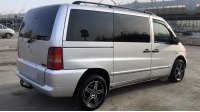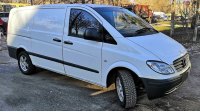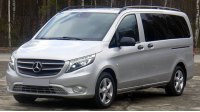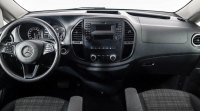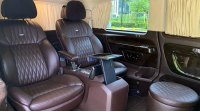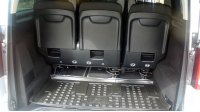Mercedes-Benz Sprinter
Mercedes-Benz Sprinter is a light commercial vehicle (M-segment according to the European classification) produced by a German automaker Daimler AG from 1995 to the present. Body design is produced as 4-door van, 2-door flatbed truck, cab-on-chassis, 4-door minibus, refrigerated truck and special vehicles (ambulance, manipulator, office, etc.). The maximum load capacity is 5.5 tons (third generation). In different countries, in addition to Mercedes-Benz, it was sold under the Dodge, Freightliner and Volkswagen brands.
First generation (903, 1995−2006)
For the first time, the car began to be produced in 1995 in Germany instead of an outdated van and truck «Mercedes-Benz TN». The new car was designated «T1N». In the same year he was awarded «International delivery van of the year» (International Van of the Year), which is awarded annually by specialist journalists to new models of vans that appear on the European market. Development began back in 1992, and prototypes were tested in Spain, Germany and France for three years. Over 11 years of the life of the first generation, more than 1.3 million cars were produced.
The suspension is completely independent, unlike its predecessor. Front transverse spring, rear two longitudinal springs. Steering rack and pinion with power steering. The engine was located in front under the hood, rear-wheel drive. A little later, a model with all-wheel drive appeared. The body was of three types - a van, a minibus and a flatbed truck.
Engines until 2000 were mainly diesel of the following characteristics - 2.3 liters «208 D» / «308 D» / «408 D» (2299 cm3, OM601, I4, 78 hp), 2.9 liters «210 D» / «310 D» / «410 D» (2874 cm3, OM602, I5, 101 hp) and 2.9 liters «212 D» / «312 D» / «412 D» (2874 cm3, OM602, I5, 120 hp). The gasoline engine was one throughout the entire production period of the 2.3-liter generation «214» / «314» / «414» (2295 cm3, M111, I4, 141 hp). The gearbox was installed 5-speed automatic or mechanical.
In 2000, the car was upgraded. Diesel engines have been updated to the following specifications - 2.1 liters (2148 cm3, OM611, I4, 81, 108 and 127 hp) and 2.7 liters (2685 cm3, OM612/OM647, I5, 154 hp). These engines had a fuel system «Common Rail». An inscription was added to the name of the cars «CDI». All cars began to be equipped with an electronic stabilization system (ESP). In 2003, another update was carried out, which mainly affected the appearance.
In North America, production and sales began in 2001 under the brand «Freightliner», and since 2003 under the brand «Dodge». In Japan, the car was sold under the name «Transporter T1N» due to an overlap with the name of a Japanese compact passenger car «Toyota Sprinter». In Russia in 2013, the production of a modernized (model after 2000) car with the name «Sprinter Classic», which is assembled at the Gorky Automobile Plant to the present.
Second generation (906, 2006−2018)
Next generation with code «906», also known as «NCV3» (New Concept Van 3) introduced in Europe in 2006. In North America, the car appeared in 2007. Received an award from journalists «Van of the Year» in 2007 and 2008. The body was a 2-door flatbed truck, as well as a 4-door van and minibus. The shortest wheelbase was around 3000mm, the longest was 4025mm. Externally, the car received increased headlights and a radiator grille, changed the shape of the front side windows, as well as other less noticeable changes.
The engine was located in the front, rear-wheel drive, and some cars are available with all-wheel drive. Gasoline engine increased in volume to 3.5 liters (3498 cm3, M272, V6) 268 hp There were two modifications of diesel engines - 2.1 liters (2148 cm3, OM646, I4, 107 hp) and 3.0 liters (2987 cm3, OM642, V6, 190 hp). All diesels are equipped with a fuel system «Common Rail». Transmissions were 6-speed manual, 5 or 7-speed automatic. Some models were fitted with air suspension.
In 2013, the car was updated. Some driver assistance features have been added, such as blind spot monitoring, collision avoidance system, electronic crosswind protection, lane keeping assist, automatic high/low beam switching, etc. A new generation radio was installed inside, the exhaust level was brought into line with the standards «Euro VI». Also changed the grille, headlights, upholstery, steering wheel.
In 2014, another update was carried out, which affected the radiator grille, and also added new engines. 1.8 liter petrol (1796 cm3, M271, I4, 156 hp), which can also run on natural gas. Diesel engines with technology «BlueTEC» volume of 2.1 liters (2143 cm3, OM651, I4, twin turbo, 94, 127 and 161 hp) and 3.0 liters (2987 cm3, OM642, V6, turbo, 187 hp).
Third generation (907/910, 2018-present)
Third generation car with code «907/910» and designation «The VS30 was unveiled on February 6, 2018 at the newly built Mercedes-Benz logistics center on Mercator Island in the city of Duisburg. For the first time, in addition to rear-wheel drive, front-wheel drive models appeared. They have 80 mm lower floor, which makes loading more convenient. The body is available as a van, bus, flatbed truck, cab on chassis.
The vehicle is equipped with many of the existing driver assistance and safety systems found on passenger cars. From the new - all-round cameras, car parking, rain sensor, keyless entry. New multimedia system «MBUX» (Mercedes-Benz User Experience) together with the service «Mercedes PRO connect» ensures constant networking and communication with other drivers and the dispatcher, who has access to all parameters and the location of all connected vehicles, which makes fleet management as efficient as possible.
Petrol engine one 3.0 liter (2997 cm3, M276, V6, 190 hp). Three modifications of diesel engines - all with a volume of 2.1 liters (2143 cm3, OM651, I4, twin turbo, 114, 143 and 163 hp). Front-wheel drive cars are equipped with new gearboxes - 6-speed manual or 9-speed automatic.
Mercedes-Benz Vito (V-Class)
Mercedes-Benz V-Class - a large minivan manufactured by a German automobile company «Mercedes-Benz» in the form of a panel van (Vito) or passenger bus (Viano). In the passenger segment, it was sold under the brand name «V-Class». The start of production was in 1996 and to date the model has three generations. «V-Class» available in both rear-wheel drive and all-wheel drive configurations, in three lengths and two wheelbases. The engine is located transversely in front, both petrol and diesel models are available with a manual or automatic transmission.
First generation (W638, 1996−2003)
First generation «Vito» with the code W638 began to be produced in 1996 at a plant in Spain. The name Vito comes from the city of Vitoria-Gasteiz in the same place in Spain where these minivans were produced. Initially, they wanted to call the car Vitoria, but Seat protected this name for its own use.
The first generation Vito was produced in the following variants:
- Mixto with two rows of seats and a small cargo area;
- Minibus Transporter with three rows of seats;
- Panel van with one row of seats and a large cargo area;
- Motorhome «Vito F» or «Vito Marco Polo»;
- Named lightweight variant «V-Class».
The length of the car was 4660 mm, width 1870 mm, height 1844 mm, wheelbase 3000 mm and curb weight 2700 kg. In 1996, the Vito was named van of the year.
The range of gasoline engines consisted of three models with a volume of 2.0 liters (1998 cm3, M 111 E 20, R4, 129 hp), 2.3 liters (2295 cm3, M 111 E 23, R4, 143 hp) and 2.8 liters (2792 cm3, VR6, 174 hp). Diesel engines were installed with a volume of 2.3 liters (2299 cm3, OM 601, R4, 79/98 hp) and 2.2 liters (2151 cm3, OM 611, 82/102/122 hp). The transmission was either a five-speed manual or a four-speed automatic. The drive was only on the front wheels.
Second generation (W639, 2003−2014)
The second generation Mercedes Vito began production in July 2003 with the code W639 for the regular version and V639 for the extended version. The most important difference is the rear-wheel drive, which made it possible to slightly reduce the turning radius. Body length ranges from 4750 to 5223 mm, width 1901 mm, height 1903 mm, wheelbase from 3200 to 3430 mm. The curb weight is from 1790 to 2190 kg. The Vito is available in three versions:
- Panel van with up to three seats and a large cargo compartment;
- Mixto with up to six seats in two rows and a smaller luggage compartment;
- Station wagon with up to nine seats.
The Viano as a passenger car is available in four equipment variants: Trend, Fun, Ambiente and Avantgarde. Since 2007, a model has appeared with the high-end X-Clusive equipment option. The main production of the second generation Vito and Viano was also carried out in Spain in the city of Vitoria-Gasteiz, but since 2008 the assembly has been established in Mexico, since 2010 in China. In 2005, the Vito was named van of the year. In October 2010, a facelift of the model was introduced. In addition to the engines, the appearance of the lighting system and the radiator grille has changed.
Gasoline engines installed only 6-cylinder V-shaped following volumes - 3.2 liters (3199 cm3, M112 E32, 190/218 hp), 3.5 liters (3498 cm3, M272 E35, 258 hp) and 3.7 liters (3724 cm3, M112 E37, 231 hp). Diesel engines were installed as 4-cylinder in-line 2.2-liter (2143 cm3, OM 651 DE 22, 95/136/163 hp) and 2.3 liters (2148 cm3, OM 646 DE 22, 88/95/116/150 hp), and 6-cylinder V-shaped with a volume of 3.0 liters (2987 cm3, OM 642 DE 30, 204/224 cm3). The transmission was a 6-speed manual and a 5-speed automatic (TouchShift).
Third generation (W447, 2014-present)
The third generation of small vans from the German car manufacturer «Daimler AG» issued with code W447. For the first time, this generation of the van will be available in North America under the name «Metris». The rear side doors are made in the form of sliding doors. The drag coefficient is 0.32. Cars have a load-bearing body made of sheet steel. Two wheelbases are available: 3200 mm and 3430 mm, and three body lengths: 4895 mm, 5140 mm and 5370 mm. The width is 1928 mm, the height is 1880 mm. Curb weight from 1800 kg to 1976 kg. MacPherson strut front suspension with triangular wishbones, semi-independent wishbone rear suspension. Rear-wheel drive, and all-wheel drive models became available.
Until 2019, 2.0-liter gasoline engines were installed (1991 cm3, M274 DE 20, R4, 211 hp), as well as diesel engines with a volume of 1.6 liters (1598 cm3, OM622 DE 16, R4, 88/114 hp) and 2.1 liters (2143 cm3, OM651 DE 22, R4, 136/163/190 hp). After 2019, diesel engines have been updated to the following models - 1.8 liters (1749 cm3, OM622 DE 17, R4, 102/136 hp) and 2.0 liters (1950 cm3, OM654, R4, 136/163/190/237 hp), all with single or twin turbocharging. Transmission 6-speed manual and 7 or 9-speed automatic.
In 2018, Mercedes-Benz introduced an all-electric version of the e-Vito with an 84 kW electric motor and a range of 150 km. In early 2019, Mercedes introduced an electric V-class called the EQV. Unlike the Vito van, the Mercedes-Benz EQV is a large passenger vehicle with up to eight seats. The power of its engine is 15 kW, the cruising range is 350 km.

